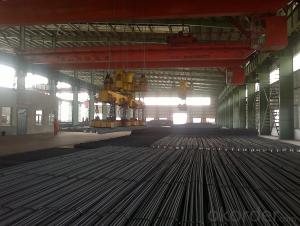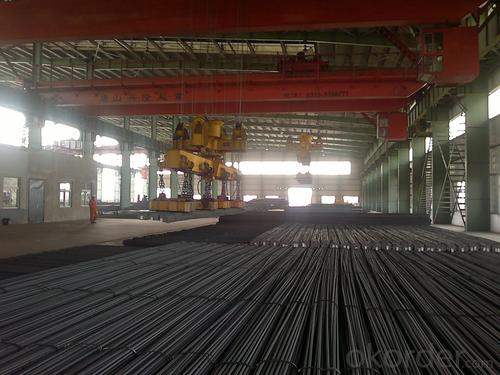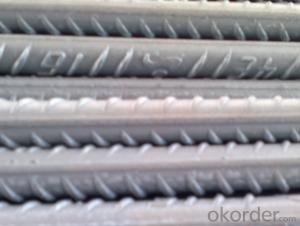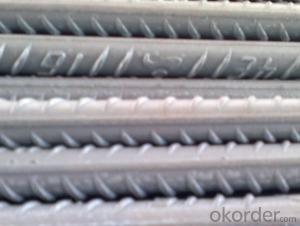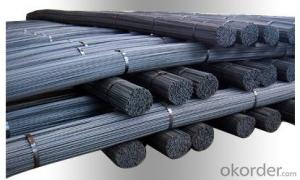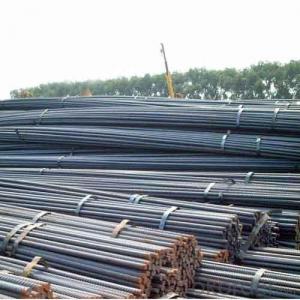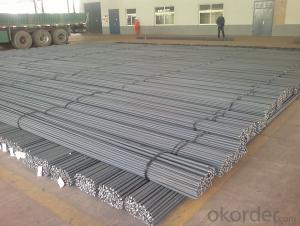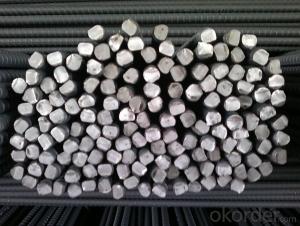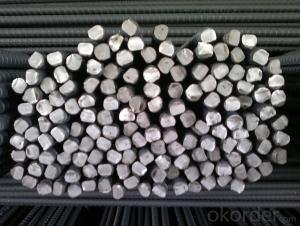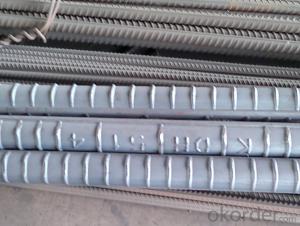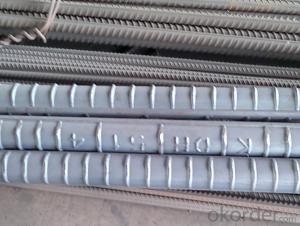Hot Rolled Deformed Steel Rebars ASTM, GB HRB400Cr, HRB500Cr
- Loading Port:
- Shanghai
- Payment Terms:
- TT or LC
- Min Order Qty:
- 100 m.t.
- Supply Capability:
- 200000 m.t./month
OKorder Service Pledge
OKorder Financial Service
You Might Also Like
OKorder is offering Hot Rolled Deformed Steel Rebars ASTM, GB HRB400Cr, HRB500Cr at great prices with worldwide shipping. Our supplier is a world-class manufacturer of steel, with our products utilized the world over. OKorder annually supplies products to African, South American and Asian markets. We provide quotations within 24 hours of receiving an inquiry and guarantee competitive prices.
Product Applications:
Hot Rolled Deformed Steel Rebars ASTM, GB HRB400Cr, HRB500Cr are ideal for structural applications and are widely used in the construction of buildings and bridges, and the manufacturing, petrochemical, and transportation industries.
Product Advantages:
OKorder's Hot Rolled Deformed Steel Rebars ASTM, GB HRB400Cr, HRB500Cr are durable, strong, and wide variety of sizes.
Main Product Features:
· Premium quality
· Prompt delivery & seaworthy packing (30 days after receiving deposit)
· Can be recycled and reused
· Mill test certification
· Professional Service
· Competitive pricing
Product Specifications:
Manufacture: Hot rolled
Grade: HRB400, HRB500 etc
Certificates: ISO, SGS, BV, CIQ
Length: 6m – 12m, as per customer request
Packaging: Export packing, nude packing, bundled
Deformed Steel Bar | ||
Diameter (MM) | Cross Sectional Area (MM2) | Theorectical Weight (KG/M) |
6 | 28.27 | 0.222 |
8 | 50.27 | 0.395 |
10 | 78.54 | 0.617 |
12 | 113.1 | 0.888 |
14 | 153.9 | 1.21 |
16 | 201.1 | 1.58 |
18 | 254.5 | 2 |
20 | 314.2 | 2.47 |
22 | 380.1 | 2.98 |
25 | 490.9 | 3.85 |
28 | 615.8 | 4.83 |
32 | 804.2 | 6.31 |
36 | 1018 | 7.99 |
40 | 1257 | 9.87 |
FAQ:
Q1: Why buy Materials & Equipment from OKorder.com?
A1: All products offered byOKorder.com are carefully selected from China's most reliable manufacturing enterprises. Through its ISO certifications, OKorder.com adheres to the highest standards and a commitment to supply chain safety and customer satisfaction.
Q2: How do we guarantee the quality of our products?
A2: We have established an advanced quality management system which conducts strict quality tests at every step, from raw materials to the final product. At the same time, we provide extensive follow-up service assurances as required.
Q3: How soon can we receive the product after purchase?
A3: Within three days of placing an order, we will arrange production. The normal sizes with the normal grade can be produced within one month. The specific shipping date is dependent upon international and government factors, the delivery to international main port about 45-60days.
Images:
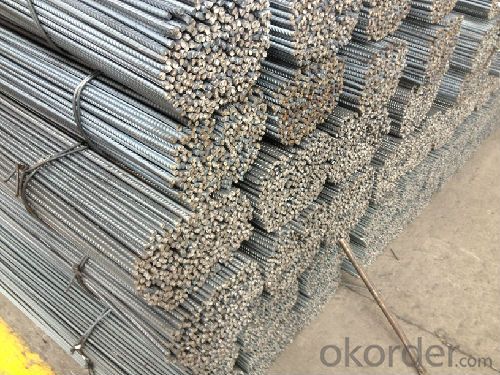

- Q: Are there any limitations in using steel rebars in construction?
- Yes, there are limitations in using steel rebars in construction. Some limitations include susceptibility to corrosion in certain environments, high thermal conductivity, and potential for expansion or contraction due to temperature changes. Additionally, steel rebars have a relatively high weight, which can make transportation and installation more challenging. However, these limitations can be mitigated through proper design, material selection, and maintenance strategies.
- Q: How do steel rebars affect the overall weight of a concrete structure?
- Steel rebars typically increase the overall weight of a concrete structure. This is because steel rebars add additional mass to the concrete, making it heavier. However, the weight increase is generally proportionate to the added strength and durability that the rebars provide, making them essential for reinforcing the structure and improving its structural integrity.
- Q: What are the safety precautions when working with steel rebars?
- To minimize the chance of accidents and injuries when working with steel rebars, it is crucial to adhere to various safety measures. Consider the following key precautions: 1. Personal Protective Equipment (PPE): Ensure that you always wear the appropriate PPE, which includes safety glasses or goggles, gloves, steel-toed boots, and a hard hat. This will shield you from potential dangers like falling objects, flying debris, or accidental contact with sharp edges. 2. Training and awareness: Make certain that all workers involved in handling steel rebars receive proper training on safe work practices and are knowledgeable about the potential hazards associated with this work. Regular safety meetings and reminders can help reinforce this knowledge. 3. Proper lifting techniques: Given that steel rebars can be heavy and difficult to handle, employ proper lifting techniques such as bending at the knees and using leg muscles to avoid strains or back injuries. If necessary, utilize mechanical lifting aids like cranes or hoists to lessen the physical strain on workers. 4. Secure storage and handling: Store steel rebars securely and in an organized manner to prevent them from falling or rolling onto workers. When moving or transporting rebars, ensure they are properly secured to prevent shifting or falling during transit. 5. Cutting and bending precautions: When cutting or bending steel rebars, use appropriate tools and equipment like bolt cutters or rebar benders. Always wear protective gloves and ensure that the cutting or bending area is clear of other workers to prevent accidental injuries. 6. Fall protection: When working at elevated heights, such as during the installation of rebars in elevated structures, ensure that proper fall protection measures are in place. This may involve using safety harnesses, guardrails, or safety nets to prevent falls. 7. Fire prevention: Steel rebars can produce sparks when cut or welded, so it is essential to have adequate fire prevention measures in place. Clear the work area of flammable materials, have readily available fire extinguishers, and adhere to appropriate welding safety protocols. 8. Regular equipment maintenance: Keep all tools and equipment used for handling steel rebars well-maintained and in good working condition. Regularly inspect them for any damage or defects that could compromise safety. By adhering to these safety precautions, you can establish a safer working environment when dealing with steel rebars and reduce the risk of accidents or injuries.
- Q: What are the main properties of steel rebars?
- Steel rebars, also referred to as reinforcing bars, play a vital role in reinforced concrete structures due to their numerous advantageous characteristics. Firstly, steel rebars possess a high tensile strength, which enables them to withstand substantial pulling forces and effectively reinforce concrete to prevent cracking and structural failure. Secondly, steel rebars exhibit exceptional ductility, meaning they can deform under stress without fracturing. This flexibility allows them to absorb energy during seismic events or extreme loads, enhancing the overall performance and resilience of the reinforced concrete. Moreover, steel rebars are manufactured with a protective layer, such as epoxy or galvanized coating, to ensure corrosion resistance. This property is crucial as exposure to moisture, chloride ions, and other corrosive elements can significantly weaken the rebars and compromise the structural integrity. In addition, steel rebars can be easily welded together, facilitating efficient and effective construction. This feature enables the rebars to be connected seamlessly, forming a continuous and robust reinforcement network that enhances the overall strength and stability of the concrete structure. Furthermore, steel rebars possess thermal compatibility with concrete, meaning they have similar expansion and contraction properties. This characteristic minimizes the risk of cracking or structural damage caused by temperature changes, ensuring the long-term durability and stability of reinforced concrete structures. Lastly, steel rebars are widely available and relatively cost-effective compared to alternative reinforcing materials. This affordability, combined with their exceptional mechanical properties, makes them a popular choice for structural reinforcement in various construction projects. In conclusion, steel rebars offer high tensile strength, ductility, corrosion resistance, weldability, thermal compatibility, and cost-effectiveness. These properties are indispensable for providing structural strength and durability to reinforced concrete structures.
- Q: Can steel rebars be used in structures with high resistance to creep?
- Yes, steel rebars can be used in structures with high resistance to creep. Steel rebars are commonly used in reinforced concrete structures and provide strength and durability to the overall structure. Creep is the gradual deformation of a material under constant stress over time. While steel does exhibit some creep, it is considered to have a low creep rate compared to other materials such as concrete or timber. Additionally, the use of rebars in reinforced concrete structures can help distribute the load and minimize the effects of creep by adding stiffness and reducing the overall stress on the concrete. Therefore, steel rebars can be effectively used in structures with high resistance to creep when designed and installed properly.
- Q: Can steel rebars be used in the construction of shopping complexes?
- Yes, steel rebars can be used in the construction of shopping complexes. Steel rebars are commonly used as reinforcement in concrete structures, including shopping complexes, due to their high strength and ability to withstand heavy loads. They provide structural integrity and enhance the overall strength and durability of the building. Steel rebars are also resistant to corrosion, which is crucial for structures like shopping complexes that are exposed to varying weather conditions and high foot traffic. Additionally, the use of steel rebars allows for flexibility in design and construction, enabling architects and engineers to create complex and unique structures. Overall, steel rebars are a reliable and widely used material for reinforcing concrete in the construction of shopping complexes.
- Q: What are the common types of coatings applied to steel rebars for corrosion protection?
- The common types of coatings applied to steel rebars for corrosion protection include epoxy, zinc, and polyethylene.
- Q: How are steel rebars protected against extreme weather conditions?
- Steel rebars are protected against extreme weather conditions through various methods such as epoxy coating, galvanization, and concrete cover. These protective measures prevent corrosion and degradation of the rebars, ensuring their durability and strength even in harsh weather conditions.
- Q: What is the maximum length of a steel rebar available in the market?
- Manufacturers and the construction industry dictate the maximum length of steel rebar found in the market, which can differ. Typically, steel rebar is available in lengths ranging from 20 feet (6 meters) to 60 feet (18 meters), favored due to transportation and handling limitations. Nevertheless, it is crucial to acknowledge that manufacturers can accommodate custom lengths for project-specific needs upon special request.
- Q: What is the effect of exposure to high humidity on steel rebars?
- Exposure to high humidity can have a detrimental effect on steel rebars as it can promote corrosion, leading to loss of structural integrity and reduced lifespan of the rebars.
Send your message to us
Hot Rolled Deformed Steel Rebars ASTM, GB HRB400Cr, HRB500Cr
- Loading Port:
- Shanghai
- Payment Terms:
- TT or LC
- Min Order Qty:
- 100 m.t.
- Supply Capability:
- 200000 m.t./month
OKorder Service Pledge
OKorder Financial Service
Similar products
Hot products
Hot Searches
Related keywords
